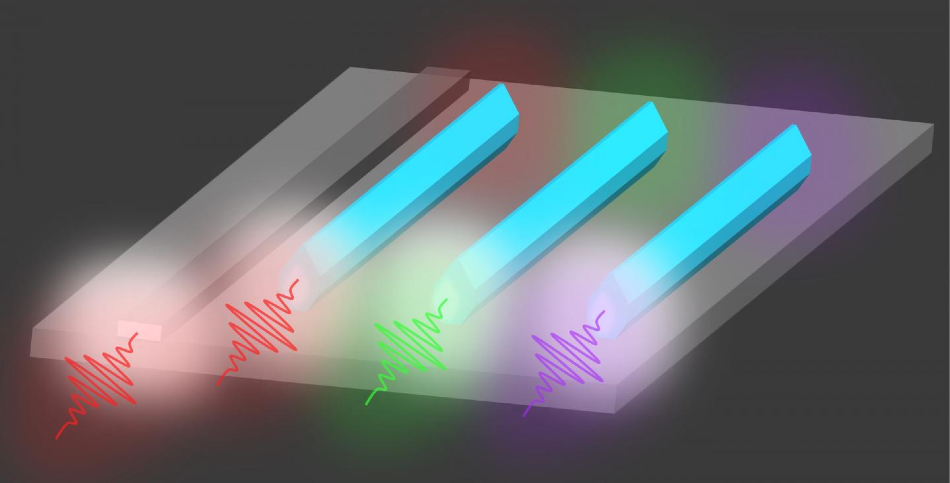Mar 5 2020
At the Hong Kong University of Science and Technology (HKUST), scientists have developed the world’s first 1.5 μm III-V laser, grown directly on the industry-standard 220 nm silicon-on-insulator (SOI) wafers without buffer.
 Schematic of III-V laser array directly grown on Si-photonics 220 nm SOI platform. Image Credit: HKUST.
Schematic of III-V laser array directly grown on Si-photonics 220 nm SOI platform. Image Credit: HKUST.
This study could potentially open the door to the “holy grail” for current silicon (Si) photonics research.
Through smooth bridging of the passive Si-based photonic devices with the active III-V light sources, the lasers could be used as light sources in integrated circuits to considerably enhance the power efficiency, cost-effectiveness, and circuit speed.
In other traditional methods for combining III-V lasers on Si in the literature, thick III-V buffers measuring a few micrometers are used to minimize the defect densities. This poses huge difficulties for efficient light interfacing between the Si-based waveguides and the epitaxial III-V lasers.
As a first, the team of researchers headed by Prof. LAU Kei-May of HKUST’s Department of Electronic and Computer Engineering and Post-doctoral Fellow Dr HAN Yu developed a new growth scheme to avoid the need for thick III-V buffers and thus enabled efficient light coupling into the Si-based waveguides. The bufferless feature characterizes completely incorporated Si-based photonic integrated circuits.
This feature has allowed the initial demonstration of 1.5 μm III-V lasers grown directly on the industry-standard 220 nm SOI wafers using metal-organic chemical vapor deposition (MOCVD). Earlier demonstrations would need thick SOI wafers or non-industry-standard bulk Si.
The study outcomes were recently reported online in the Optica journal in February 2020.
The global increase in the demand for Internet services and the digitization of people’s lives have resulted in an enormous amount of digital data being produced, processed, stored, and transferred.
Silicon is a material that has been used extensively in the manufacturing of semiconductors, which are integrated into virtually every piece of communications technology that people rely on a daily basis, from computers and smartphones to data centers and satellite communications.
However, optimization of the efficiency of traditional electronic data systems cannot match the increasing data traffic, as it requires the embedding of photonic functionalities onto the typical Si-based electronic platform.
The integration could generate optoelectronic integrated circuits with supreme speed and functionalities, and allow novel applications. However, the essential difference between III-V and Si materials makes it highly difficult to directly grow III-V functionalities on the Si-platform.
At HKUST’s Phonics Technology Center, for more than 10 years, Prof. Lau’s team has taken efforts to embed III-V materials and functionalities on mainstream silicon wafers, innovating and improving several ways to enhance the performance of III-V lasers grown on Si. Their aim is to steadily cater to the needs of the industry. This study forms part of the team’s project on monolithic integration of III-V lasers on silicon.
Initially, the team devised a special growth scheme to directly grow high-quality III-V materials on the industry-standard 220 SOI platforms. Subsequently, the researchers defined and proved the outstanding crystalline quality of these epitaxial III-V materials via extensive photoluminescence and transmission electron microscopy measurements.
The researchers designed and developed the air-cladded laser cavities through numerical simulations and finally tested the devices. They found that the lasers had the capability to sustain low-threshold and room-temperature lasing in the technologically significant 1.5 μm band under optical excitation.
If practically applied, our technology could enable a significant improvement of the speed, power consumption, cost-effectiveness, and functionality of current Si-based integrated circuits. Our daily electronic devices, such as smartphones, laptops and TVs—basically everything connected to the internet—will be much faster, cheaper, using much less power and multi-functional.
Kei-May Lau, Professor, Department of Electronics and Computer Engineering, Hong Kong University of Science and Technology
The demonstration has ensured the viability and potential for monolithic integration of III-V lasers on the industry-standard 220 nm SOI wafers in a compact, cost-effective, and scalable manner.
The next step of our research will be to design and demonstrate the first electrically-driven 1.5 μm III-V lasers directly grown on the 220 nm SOI platforms, and devise a scheme to efficiently couple light from the III-V lasers into Si-waveguides and thereby conceptually demonstrate fully-integrated Si-photonics circuits.
Dr Yu Han, Post-Doctoral Fellow, Hong Kong University of Science and Technology